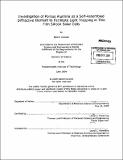Investigation of porous alumina as a self-assembled diffractive element to facilitate light trapping in thin film silicon solar cells
Author(s)
Coronel, Naomi (Naomi Cristina)
DownloadFull printable version (3.249Mb)
Other Contributors
Massachusetts Institute of Technology. Dept. of Materials Science and Engineering.
Advisor
Lionel C. Kimerling.
Terms of use
Metadata
Show full item recordAbstract
Thin film solar cells are currently being investigated as an affordable alternative energy source because of the reduced material cost. However, these devices suffer from low efficiencies, compared to silicon wafer solar cells, due to the poor absorption of longer wavelengths of light in the very thin active layer. One method of improving the efficiency of thin film solar cells is to use light trapping to increase the path length of long wavelength light to increase the probability of absorption. Previous work has yielded a new light trapping design, the textured photonic crystal, which incorporates a backside distributed Bragg reflector with a diffraction grating for large-angle diffraction. This study develops a simple and cost-effective fabrication method of using porous alumina as a self-assembled textured photonic crystal. Porous alumina is an attractive material because under certain anodization conditions, the pores form an ordered array. The ordered pore structure on the surface can serve as a diffraction grating, while alternating the pore size could vary the refractive index and form a distributed Bragg reflector. In this thesis, the arrangement of pores on the alumina surfaces is determined using a Fourier transform analysis. Results show that the average interpore distance of the samples depends linearly on the anodization voltage during pore initiation. These results will help to understand the pore initiation process and control that process to minimize fabrication steps.
Description
Thesis (S.B.)--Massachusetts Institute of Technology, Dept. of Materials Science and Engineering, 2009. Cataloged from PDF version of thesis. Includes bibliographical references (p. 33).
Date issued
2009Department
Massachusetts Institute of Technology. Department of Materials Science and EngineeringPublisher
Massachusetts Institute of Technology
Keywords
Materials Science and Engineering.